Diverse Housing Styles in the UAE: A Detailed Guide
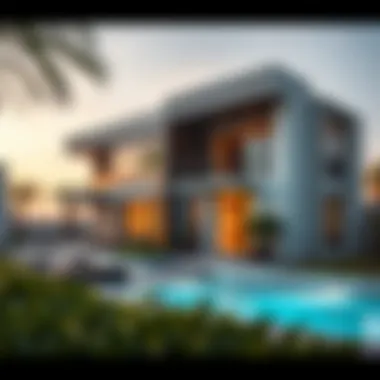
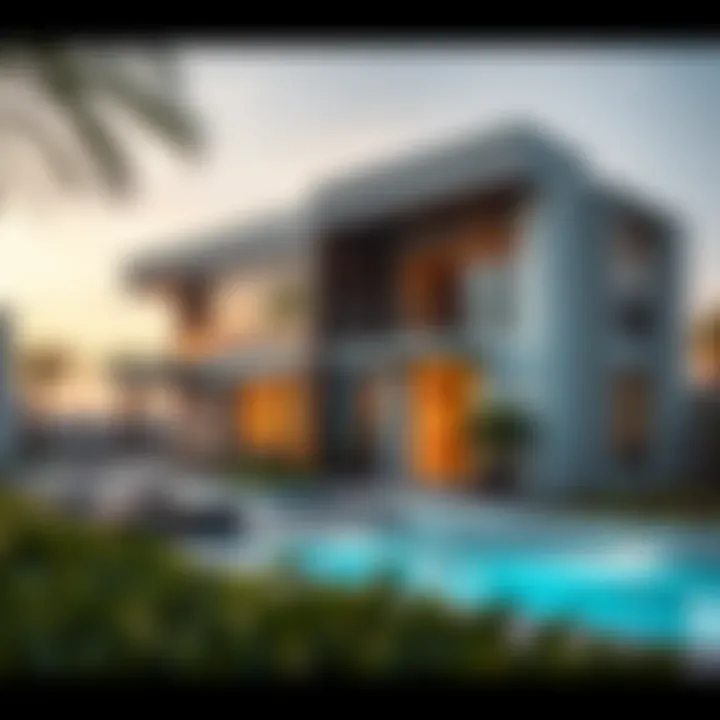
Intro
In the United Arab Emirates (UAE), the housing landscape is a tapestry of tradition blended with cutting-edge modernity. With its rapid economic growth and diverse cultural influences, the types of houses reflect a rich heritage alongside contemporary aspirations. As potential buyers, investors, or expatriates dive into this vibrant real estate market, understanding the various housing types is crucial.
Every type of home tells a story. From traditional Barasti homes made of palm fronds to luxurious villas that dot the skyline, each structure showcases unique features and cultural significance. Additionally, the high-rise apartments that seem to touch the sky represent the ambition of a nation that seeks to undertake impressive architectural feats. This article aims to demystify the spectrum of housing options available in the UAE and equip you with the knowledge to navigate this dynamic real estate market.
Understanding Housing Diversity in the UAE
The housing landscape in the United Arab Emirates (UAE) is as varied as the desert sands, shaped by centuries of rich culture, economic growth, and rapid urbanization. Understanding this diversity is crucial for anyone looking to navigate the complex real estate market, whether they are homebuyers, investors, or expatriates.
Importance of Understanding Housing Diversity
Each type of house has its own flavor, reflecting the changing lifestyles and demographics of the population. From traditional mud homes to contemporary skyscrapers, these structures tell stories of both past and present. Knowing what sets these homes apart can help individuals assess their options wisely and make informed decisions on potential investments or living arrangements.
This understanding extends beyond aesthetics; it also encompasses practical issues like pricing, maintenance, and community living. Recognizing the nuances of each housing type can significantly affect a buyer's or investor's experience.
Benefits of Recognizing Different Types of Housing
- Cultural Appreciation: Each region in the UAE has its customary architectural style, influenced by historical practices and cultural values. Understanding these styles fosters an appreciation for the diverse cultures within the country.
- Investment Insights: Knowledge of housing diversity can provide opportunities for investment. Investors can learn to identify undervalued neighborhoods or upcoming developments by recognizing trends in housing types.
- Tailored Living Solutions: Grasping the importance of housing types enables individuals to find a home that fits their requirements—be it proximity to work, lifestyle preferences, or family needs.
Delving into the unique aspects of traditional Emirati housing or contrasting it with modern urban developments offers crucial insights into how residents live, interact, and thrive in the UAE. As we progress, we will explore cultural influences on housing and the disparities between urban and rural structures—elements that are vital in understanding this dynamic landscape.
Traditional Emirati Houses
Traditional Emirati houses reflect the resilience and resourcefulness of the culture in the UAE. Emerging from a necessity to adapt to the arid climate, these structures do not just offer shelter; they symbolize a way of life intertwined with the region’s rich history. Understanding these homes is essential, as they provide insight into the social fabric and lifestyle of the Emiratis before the onset of modernity and urbanization. Moreover, grasping the significance and design of these houses can benefit homebuyers and investors interested in preserving cultural heritage or sourcing traditional aesthetics.
Barasti Houses
Barasti houses, made from palm fronds and local materials, are among the most authentic representations of traditional Emirati architecture. These simple structures were historically used by fishermen and pearl divers, showcasing an enticing blend of functionality and environmental responsiveness. One of the key aspects of Barasti houses is their coolness, offering a respite from the sweltering heat of the desert, thanks to the natural insulation provided by the palm fronds. Despite their simplicity, these homes speak volumes about the sustainability practices of the past in harmonizing with nature. The open-air construction allows for air circulation, making them cool without the use of artificial systems.
Mud Houses
Mud houses, often seen in smaller towns and rural areas, display the ingenuity of using readily available materials. Constructed from a mixture of mud, sand, and water, these homes are not only affordable but also thermal regulators, keeping the interiors cool during hot days and warm when it gets chilly at night.
These structures are characterized by thick walls and small windows to minimize the exposure to heat. However, their deterioration in harsh weather conditions poses a challenge, making maintenance crucial. While these homes evoke nostalgia and cultural preservation, potential homeowners must weigh the cost of upkeep against their aesthetic and historical value.
Architectural Features
Wind Towers
Wind towers, or Barajeel, are one of the most distinctive features of traditional Emirati architecture. These structures act as natural air conditioning, relying on the breeze to cool indoor spaces. The key characteristic of a wind tower is its height and the strategic placement of openings that catch the wind. This design is environmentally friendly and efficient, enabling cooling without electricity. In this article, it is crucial to emphasize that wind towers are not only practical but also reflect the ingenuity of traditional architects who understood their environment intimately.
While a beneficial feature for cooling, these towers can require significant maintenance, as dust and debris can clog the openings. Thus, while they are advantageous, they necessitate regular upkeep to keep functioning properly.
Courtyards
Courtyards are another vital architectural aspect in traditional Emirati houses. These open spaces serve numerous purposes, including gathering areas for family, providing ventilation, and allowing natural light to filter into the home. The key characteristic of courtyards is their ability to create a microclimate, making the surrounding areas cooler and more comfortable.
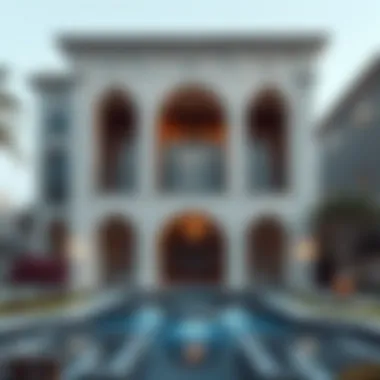
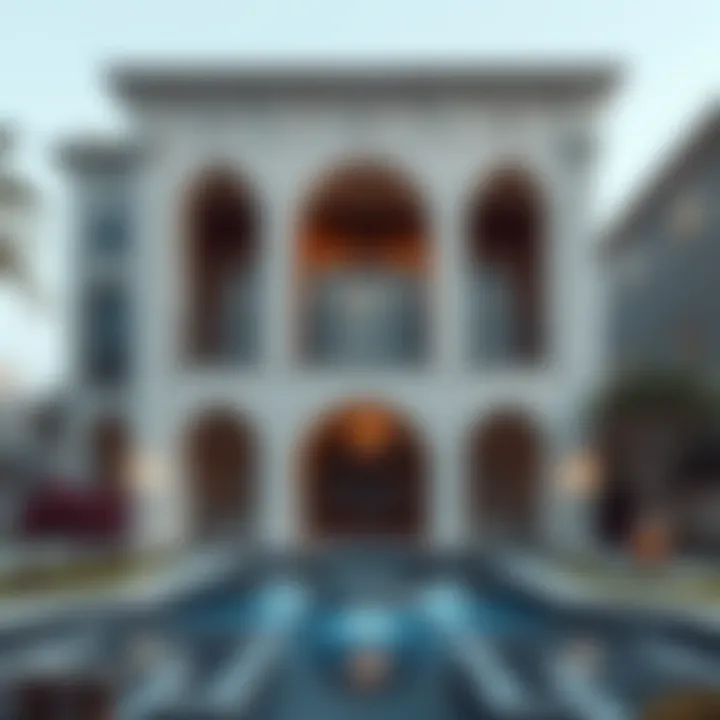
In the context of this article, coutryards are portrayed as beneficial because they enhance the social dynamics of Emirati life, providing a space where community and family bonds can flourish. However, especially in urban settings, the challenge remains in adapting these spaces to modern living, balancing between privacy and community interaction.
Privacy Considerations
Privacy is of utmost importance in Emirati culture, and this is reflected in the architectural design of houses. Traditional homes often feature high walls and separate living areas for men and women, a practice stemming from cultural norms and emphasizing social boundaries. This design is a key characteristic that promotes family unity while respecting societal standards.
Discussions in this article highlight the benefits of such considerations, illustrating a commitment to cultural values while also addressing potential drawbacks in contemporary society, where blending traditional privacy with modern expectations can be tricky. The unique design choices cater to this strong sense of privacy, essential to Emirati living, yet they challenge integration into today’s mixed-space architecture.
Modern Housing Forms
Modern housing forms in the UAE represent a significant shift in architectural trends and living standards, reflecting the rapid urbanization and growth of the region. The emergence of various styles, such as villas, apartments, and townhouses, caters to a diverse population with differing needs and budgets. This section aims to explore these modern housing types, shedding light on their features, benefits, and considerations to aid prospective buyers and residents in their housing decisions.
Villas
Luxury Villas
Luxury villas in the UAE are a hallmark of opulence and exclusivity. These homes are often located in prime areas, such as Dubai's Palm Jumeirah or Abu Dhabi's Saadiyat Island. One of the key characteristics that sets luxury villas apart is their spacious layouts and high-end finishes. Think ornate marble floors, expansive living areas, and state-of-the-art kitchen appliances.
What makes these villas particularly attractive is the appealing blend of indoor and outdoor living. Many come with private pools and beautifully landscaped gardens, providing a serene respite from the urban hustle. The only downside? The price tag can be quite hefty, making them a preferred choice for high-net-worth individuals.
Contemporary Designs
The push towards sleek, contemporary designs has transformed the housing market. These modern villas often feature clean lines, minimalist aesthetics, and large windows that promote natural light. One main advantage of contemporary designs is their adaptability; they can easily accommodate family needs or personal preferences, which is what many homebuyers seek today. However, while visually striking, these designs may sometimes lack warmth and character compared to traditional styles, possibly not appealing to everyone. Striking that right balance between modernity and comfort remains a challenge for architects.
Community Living
Community living arrangements are gaining traction in the UAE, encouraging social interaction among residents. These setups often include shared amenities like pools, gyms, and parks. The concept promotes a sense of belonging, which can be especially beneficial for expatriates seeking connections in a new country. The key characteristic here is the communal atmosphere that fosters relationships among residents. This can be a significant draw for families and young professionals alike. However, one must consider potential downsides, such as noise and privacy concerns. It’s crucial to weigh the social benefits against possible discomforts before making a choice.
Apartments
High-Rise vs Low-Rise
When it comes to apartment living, the high-rise versus low-rise debate is quite relevant. High-rise buildings, characteristic of the Dubai skyline, offer unmatched views and amenities, often accompanied by a steep price. Their skyscraping presence means more residents in a concentrated area, contributing to vibrant city life but potentially fostering a sense of anonymity. In contrast, low-rise apartments provide a more intimate setting. They tend to have fewer units, encouraging community bonds. However, they lack the panoramic views and certain conveniences high-rises may offer. Balancing location, cost, and lifestyle preference plays a crucial role in this decision.
Luxury vs Affordable Options
Within the apartment market, there's a stark divide between luxury and affordable options. Luxury apartments are typically found in prestigious areas, featuring top-tier amenities like concierge services and fitness centers. The allure lies in their advanced facilities and the status they confer, attracting affluent buyers and investors. On the other hand, affordable options are often accessible for the general population. They may not boast the same extravagant features, but they offer practicality without straining one’s budget. As such, buyers need to consider what they value more in their living arrangement—luxury or affordability.
Facilities and Amenities
The facilities and amenities provided in modern housing can significantly enhance the living experience. For instance, many apartment complexes offer gyms, swimming pools, rooftop gardens, and childcare services, making life easier for families and busy professionals. However, high costs often accompany these conveniences. While these features can enhance daily living, one should remain mindful of the associated fees which can add up quickly. Evaluating the necessity and usability of these amenities is crucial for making an informed decision.
Townhouses
Townhouses offer a unique blend between single-family homes and apartments, providing an often-desired middle ground for many buyers. These homes typically feature multiple stories, private entrances, and small gardens, offering more independence than apartments while still being part of a community. They attract a variety of residents, from young families to investors looking to rent out their properties. The blend of space and communal living can be quite appealing.
Luxury Housing Segment
In the context of the UAE's vibrant property market, the luxury housing segment stands out as a pivotal area, attracting affluent buyers from across the globe. This segment is not merely about opulence or high price tags, but also about the lifestyle that these homes offer. From state-of-the-art facilities to exclusive locations, luxury housing reflects the aspirations of a diverse buyer demographic. For investors and homeowners alike, engaging with luxury properties in this region provides an insight into the cultural zeitgeist and architectural prowess of the Emirates. This discussion will cover premium properties in Dubai, iconic developments within that landscape, and the prevailing market trends.
Premium Properties in Dubai
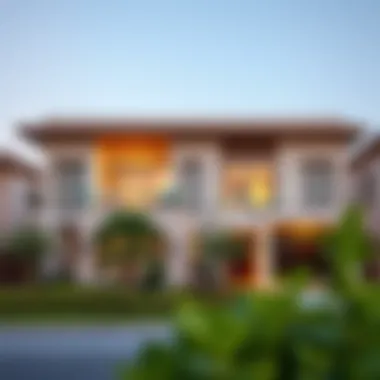
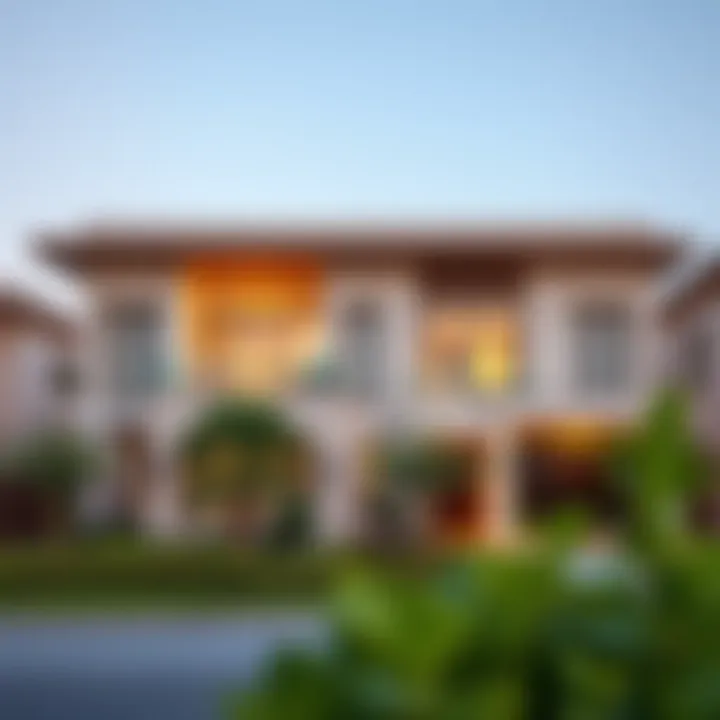
Iconic Developments
Iconic developments in Dubai symbolize the pinnacle of luxury living. These high-profile buildings often serve not just as homes, but as landmarks in their own right. Take, for instance, the Burj Khalifa, where residences offer breathtaking views and access to world-class amenities. The key characteristic of such developments is their architectural innovation and the exclusivity they promise. They often include features like private pools, lush gardens, and concierge services, making them not just places to live, but luxurious retreats.
However, the allure of iconic developments can come with a few drawbacks. The price point can be prohibitive for many, limiting accessibility. Moreover, the competition for these properties is intense, often leading to bidding wars. Still, for those who can afford it, the advantages they present—like a prestigious address and unparalleled living conditions—often outweigh the challenges.
Real Estate Market Trends
The landscape of real estate market trends in the UAE offers crucial insights into the luxury segment. Recently, there has been a noticeable shift towards sustainability and eco-friendly architectures, which profoundly influence buyer preferences. Buyers increasingly seek homes that not only provide luxury but also consider environmental impacts. With this shift, properties that meet green building standards tend to gain more interest. Additionally, the infusion of technology within luxury housing—such as smart home features and advanced security systems—has become a hallmark of modern living. Market trends showcase a growing preference for these innovative elements, rendering traditional luxury homes less favorable. The complexity of navigating these trends can pose challenges for first-time luxury buyers but also provides opportunities for strategic investment.
Investment Opportunities
Investing in the luxury housing market in the UAE offers rewards that are often unrivaled. The potential for capital appreciation in core areas like Dubai Harbour or Palm Jumeirah remains significant, driven by continuous demand for upscale living options. Further, regulatory frameworks have made it easier for foreign nationals to invest in these properties, adding to their appeal.
"Investing in luxury housing is not merely about acquiring a property; it’s about owning a piece of the Emirati dream, infused with culture and modernity."
Whether you are an investor seeking high returns or a homebuyer looking for an unparalleled living experience, the luxury housing segment in the UAE merits consideration. It stands as a testament to the nation’s commitment to excellence and visionary living.
Real Estate Regulations and Trends
The real estate landscape in the UAE is a dynamic mix of opportunities and challenges. Understanding the regulations and current trends is key for both domestic and foreign buyers looking to navigate this vibrant market. The importance of familiarizing oneself with local laws cannot be overstated; compliance with regulations ensures smooth transactions and protects investments.
When it comes to regulations, several laws govern property ownership, particularly for those not native to the emirates. Every market has its nuances, but in the UAE, the rules can vary dramatically from one emirate to another. Many expats may feel overwhelmed upon diving into the specifics. Still, being well-versed in these legal aspects saves both time and potential legal headaches down the road.
Legal Framework for Foreign Buyers
Foreigners have increasingly flocked to the UAE, drawn by its allure of luxury and investment potential. The legal framework governing property purchases for foreign nationals typically allows ownership rights in designated areas, often referred to as freehold zones. In places like Dubai, expats can buy property with full ownership, while in Abu Dhabi, specific restrictions apply, meaning careful consideration is crucial.
The process generally involves clear steps:
- Choose a location: Research areas that appeal to your lifestyle or investment goals.
- Secure financing: Many banks offer mortgages to foreigners, although terms may differ from local customers.
- Understand fees: Be aware of transaction fees, registration costs, and any applicable taxes.
For potential buyers, it's advisable to engage with local real estate professionals who can offer insights and guidance through the legal maze. This can vastly simplify the journey, ensuring one does not miss important considerations.
Market Trends and Forecasts
The UAE's real estate market is ever-evolving. Recent trends indicate a growing emphasis on eco-friendly and sustainable developments, reflecting global shifts towards greener living. As investors now prioritize projects that incorporate sustainability, properties boasting energy-efficient designs stand to gain higher valuation in the future.
Additionally, urbanization continues to drive demand. Young professionals and families flocking to cities envision comfortable living spaces. Data shows that the demand for villas and townhouses is outpacing traditional apartment living in some regions, pushing developers to innovate.
Key Trends Influencing the Market:
- Sustainability Practices: Increased focus on eco-friendly construction.
- Technological Integration: Smart homes are becoming more prevalent.
- Diverse Residential Options: More variance in types of housing to cater to different demographics.
- Rise in Remote Work: Changing lifestyle preferences impacting housing needs and location desirability.
Predictions for the coming years suggest continued resilience in the market, aided by government initiatives that foster growth. Initiatives aimed at attracting investors, along with ample public service improvements, help maintain favorable conditions for buying properties in the UAE.
"A keen sense of the market’s pulse can be a tremendous asset, helping to reveal hidden gems among the high-rises and sprawling neighborhoods of the UAE."
This proactive approach will be advantageous for homebuyers, investors, and agents alike, allowing them to stay ahead of trends and regulations. Ultimately, vigilance and understanding of this evolving market will pave the way for successful real estate ventures.
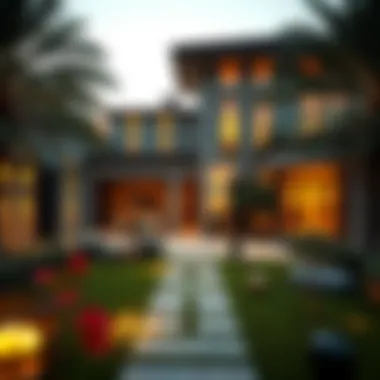
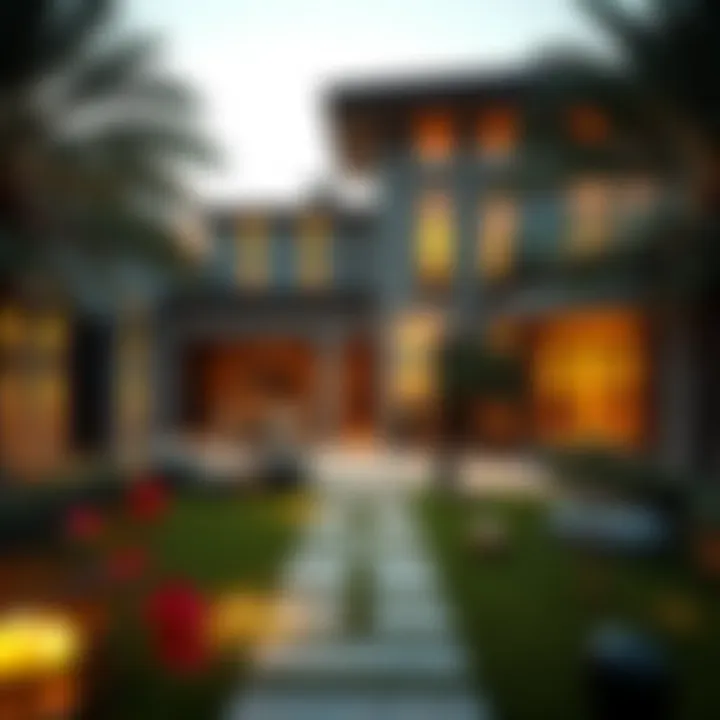
Sustainability in Emirati Housing
The surge towards sustainability in Emirati housing is becoming not just a trend but a critical component of urban development in the UAE. With rapid urbanization resulting in notable environmental challenges, housing developments are increasingly embracing eco-friendly practices. This shift is not just beneficial for the environment; it also presents long-term economic advantages and reflects a growing awareness among residents and investors towards sustainable living.
Sustainability in housing encompasses a range of initiatives including energy efficiency, water conservation, and sustainable materials, which significantly enhance the quality of life and minimize ecological footprints. The emphasis is not merely on constructing modern homes but ensuring that these homes coexist harmoniously with the environment, providing residents with healthier living spaces while reducing carbon emissions. Sustainability isn’t just good practice; it’s becoming a necessity.
Eco-Friendly Developments
Eco-friendly developments have taken root in the UAE, with a marked emphasis on incorporating natural elements into architectural designs. One prominent example is Masdar City in Abu Dhabi, a zero-carbon city that illustrates progressive sustainable living. This development utilizes solar energy, features houses built from renewable materials, and employs innovative water management systems to reduce water usage.
Key elements of eco-friendly developments include:
- Renewable Energy Sources: Adoption of solar panels and wind turbines.
- Sustainable Materials: Utilizing materials like recycled steel and non-toxic paints.
- Natural Cooling Systems: Buildings designed to create airflow which minimizes the need for air conditioning.
- Community Greenspaces: Integrating parks and gardens that encourage biodiversity.
These innovations not only resonate with environmentally-conscious residents but also align with governmental visions for a sustainable future in urban living.
Green Building Certifications
In the UAE, green building certifications play a pivotal role in promoting sustainable construction practices. Certifications such as Estidama—a system developed by the Abu Dhabi Urban Planning Council—encourage developments to adhere to sustainable standards. Buildings with this certification often cut down energy consumption by at least 30%, demonstrating a significant movement towards eco-friendliness.
Prominent certification systems include:
- LEED (Leadership in Energy and Environmental Design): Recognized internationally, it grants points for reduced energy consumption and efficient land use.
- Estidama: Focused on enhancing the quality of life and reducing environmental impact.
- BREEAM (Building Research Establishment’s Environmental Assessment Method): Another key certification incentivizing sustainable practices.
By encouraging adherence to these certificates, the UAE sets a high benchmark for environmental responsibility in construction, promoting not only energy savings but also a healthier, more sustainable lifestyle.
"Sustainable living is about choices: every design, every building decision reflects what we prioritize for ourselves and the future generations."
Future of Housing in the UAE
The landscape of housing in the UAE is shifting, shaped by social dynamics, technological advancements, and environmental considerations. Understanding the future of housing in this vibrant region is crucial for investors, homebuyers, and even urban planners. The forthcoming trends highlight innovative designs, sustainability, and smart living solutions that resonate with a modern lifestyle.
As the UAE continues to attract a diverse population, the demand for housing that caters to a variety of needs becomes ever more pressing. This article section focuses on the nuanced expectations of the future housing market, key drivers that are steering these developments, and why these considerations are vital for stakeholders.
"The future of housing is not just about buildings; it's about creating living environments that foster community and sustainability."
Innovative Architectural Trends
Innovation in architectural design is at the forefront of housing development in the UAE. Gone are the days when buildings were merely structures; today, they reflect a blend of aesthetics and functionality. With a strong focus on blending tradition with contemporary styles, UAE architects are designing homes that pay homage to the rich heritage while incorporating modern techniques and materials.
Some key trends include:
- Bio-architecture: Using living materials and natural elements in construction to enhance integration with the environment.
- Modular design: Buildings that can be assembled and reconfigured easily to suit the needs of their occupants, allowing for versatility in living space.
- Vertical Gardens: These not only add beauty but also improve air quality, making urban living greener.
The impact of these architectural trends is significant when it comes to enhancing living standards and enticing international buyers who are now looking for homes that reflect a progressive outlook.
Impact of Technology on Housing
Technology is another cornerstone that shapes the future housing market in the UAE. Smart home systems have transitioned from a luxury to a standard expectation among buyers. Automated home management systems that control lighting, security, and climate are no longer gimmicks but necessities that appeal to tech-savvy homeowners.
The influence of technology manifests itself in various ways:
- Sustainable building materials: Innovations in materials technology allow for construction methods that have lesser environmental footprints.
- Energy efficiency: Smart energy solutions such as solar panels and energy-efficient appliances are becoming increasingly popular, helping families save costs and reduce their carbon footprint.
- Urban mapping tools: These technologies guide urban planning initiatives, allowing for more efficient use of space and resources in housing developments.
As we look towards the horizon, it's clear that the future of housing in the UAE will be characterized by a harmonious blend of aesthetics, functionality, and technology, ensuring that it not only meets the present needs but also anticipates the future demands of its residents.







